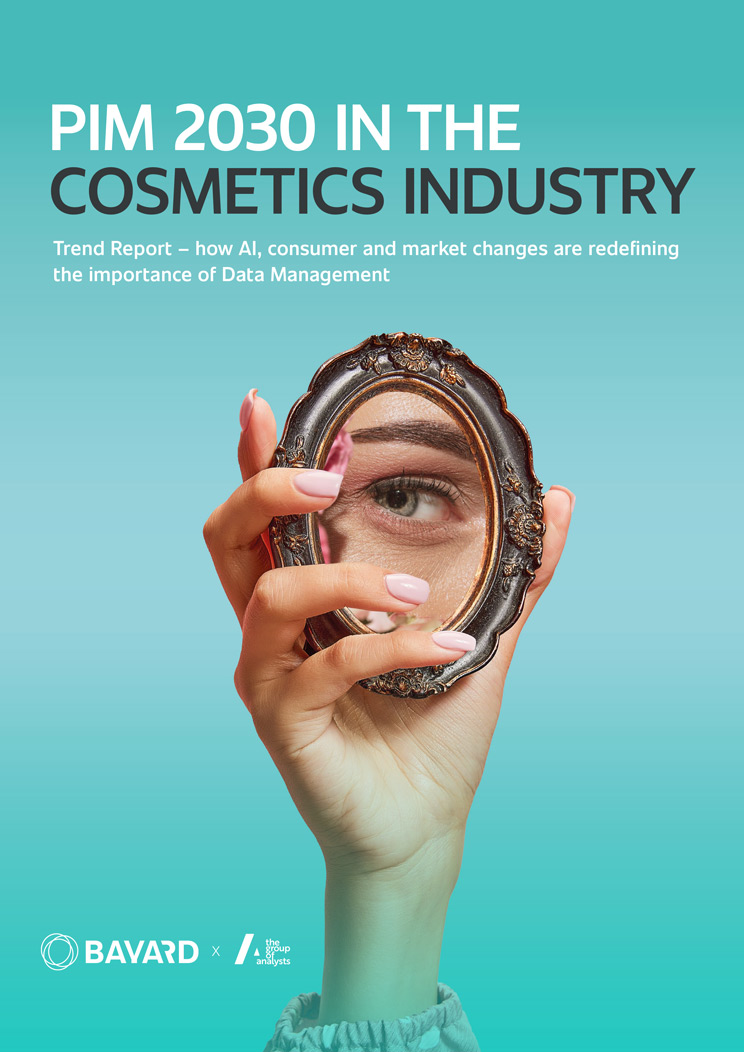14.10.2025 | BJÖRN BAYARD
The cosmetics industry thrives on innovation, trends, and emotions. Whether in stores, on social media, or on online marketplaces, customers today expect products to not only be effective but also perfectly staged and transparently presented.
Between 2022 and 2024, the global cosmetics market grew by a whopping seven per cent per year. But recently, growth has stalled. Geopolitical crises and inflation are dampening consumers’ willingness to buy. Consumers are weighing their purchasing decisions more carefully and expect more personalisation, more transparency, and more quality in customer communications – across all channels.
So the question is: how can cosmetics companies continue to shine in the future? In our new trend report, we explore this question – and in this blog article, we summarise the most important findings for you.
14.10.2025 | BJÖRN BAYARD
The cosmetics industry thrives on innovation, trends, and emotions. Whether in stores, on social media, or on online marketplaces, customers today expect products to not only be effective but also perfectly staged and transparently presented.
Between 2022 and 2024, the global cosmetics market grew by a whopping seven per cent per year. But recently, growth has stalled. Geopolitical crises and inflation are dampening consumers’ willingness to buy. Consumers are weighing their purchasing decisions more carefully and expect more personalisation, more transparency, and more quality in customer communications – across all channels.
So the question is: how can cosmetics companies continue to shine in the future? In our new trend report, we explore this question – and in this blog article, we summarise the most important findings for you.
Consumers demand personalised shopping experiences
What used to work is no longer as effective today – both influencer marketing and elaborate advertising campaigns are generating a lower ROI than in the past. Customers are becoming increasingly critical – they compare prices, check ingredients, and question brand promises. Studies show that sixty-three per cent do not believe that premium products are automatically more effective than cheaper alternatives. Quality and transparency are now much more important differentiators than a high price or a well-known brand name. In addition, price sensitivity is increasing due to the economic situation and inflation – studies show that more and more people in Europe are specifically looking for cheaper beauty products or switching to new manufacturers.
This makes it all the more important to address customers in a comprehensive and targeted manner, reaching them in the right place with the right message. Beauty brands today need to communicate in an informative and effective way – and this has a major impact on Product Content and its syndication across the relevant output channels.
What used to work is no longer as effective today – both influencer marketing and elaborate advertising campaigns are generating a lower ROI than in the past. Customers are becoming increasingly critical – they compare prices, check ingredients, and question brand promises. Studies show that sixty-three per cent do not believe that premium products are automatically more effective than cheaper alternatives. Quality and transparency are now much more important differentiators than a high price or a well-known brand name. In addition, price sensitivity is increasing due to the economic situation and inflation – studies show that more and more people in Europe are specifically looking for cheaper beauty products or switching to new manufacturers.
This makes it all the more important to address customers in a comprehensive and targeted manner, reaching them in the right place with the right message. Beauty brands today need to communicate in an informative and effective way – and this has a major impact on Product Content and its syndication across the relevant output channels.
The stage is getting bigger – and more complex
In the consumer goods sector in particular, the number of relevant communication channels is constantly increasing. In addition to the important brick-and-mortar retail sector, where consumers continue to regularly go on discovery tours to learn about new beauty brands, brands today must be active on numerous online platforms such as marketplaces, web shops, and social media.
This scenario has particular implications for product communication: while brand messages and product information must always be consistent and quality-assured, the approach itself must be adapted to the target group and the tone of the respective platform. All of this greatly increases the complexity of data management.
PIM: the most important communication tool for beauty brands
The rise in communication channels makes it all the more important to use a powerful PIM system that is deeply embedded in business and data processes and thus comprehensively supports brands in the creation, maintenance, provision, and distribution of effective product messages:
1. Scalability
Whether it’s new markets and output channels, restructuring, or product range changes, a flexible PIM system can handle any change.
2. Reliable data quality
Each output channel has its own rules for product information – a powerful PIM ensures that product content is delivered in a manner appropriate to the channel.
3. Personalised communication
Generic messages are a thing of the past. With AI-supported PIM, companies can effectively customise content – from product texts to images.
4. Faster processes
Automated workflows reduce manual work, accelerate time-to-market and save resources.
5. Compliance & transparency
Stricter regulations require quality-assured product information and a transparent supply chain – no problem with a modern PIM.
The stage is getting bigger – and more complex
In the consumer goods sector in particular, the number of relevant communication channels is constantly increasing. In addition to the important brick-and-mortar retail sector, where consumers continue to regularly go on discovery tours to learn about new beauty brands, brands today must be active on numerous online platforms such as marketplaces, web shops, and social media.
This scenario has particular implications for product communication: while brand messages and product information must always be consistent and quality-assured, the approach itself must be adapted to the target group and the tone of the respective platform. All of this greatly increases the complexity of data management.
PIM: the most important communication tool for beauty brands
The rise in communication channels makes it all the more important to use a powerful PIM system that is deeply embedded in business and data processes and thus comprehensively supports brands in the creation, maintenance, provision, and distribution of effective product messages:
1. Scalability
Whether it’s new markets and output channels, restructuring, or product range changes, a flexible PIM system can handle any change.
2. Reliable data quality
Each output channel has its own rules for product information – a powerful PIM ensures that product content is delivered in a manner appropriate to the channel.
3. Personalised communication
Generic messages are a thing of the past. With AI-supported PIM, companies can effectively customise content – from product texts to images.
4. Faster processes
Automated workflows reduce manual work, accelerate time-to-market and save resources.
5. Compliance & transparency
Stricter regulations require quality-assured product information and a transparent supply chain – no problem with a modern PIM.
Current PIM trends
The challenges facing the cosmetics industry and all other sectors require a flexible and holistic approach to product data. Accordingly, the PIM market is increasingly moving toward innovation, AI, integration capabilities, and flexibility:
Data exchange between industry and commerce
Manufacturers and retailers depend on smooth processes for Content Sourcing and Syndication. This is the only way to efficiently handle growing amounts of data.
Personalisation as a game changer
The era of mass messaging is over. Consumers expect a tailored approach – tailored to the channel and target group. Companies can only meet these expectations with the help of AI and automation.
AI as an efficiency booster
From automatic classification to text creation, AI reduces the effort involved in creating, maintaining, and distributing product content and opens up new possibilities.
Data quality as a foundation
The higher the degree of automation and consumer expectations, the greater the focus on data quality: PIM systems must meet these requirements with comprehensive validation and data quality assurance functions.

Current PIM trends
The challenges facing the cosmetics industry and all other sectors require a flexible and holistic approach to product data. Accordingly, the PIM market is increasingly moving toward innovation, AI, integration capabilities, and flexibility:
Data exchange between industry and commerce
Manufacturers and retailers depend on smooth processes for Content Sourcing and Syndication. This is the only way to efficiently handle growing amounts of data.
Personalisation as a game changer
The era of mass messaging is over. Consumers expect a tailored approach – tailored to the channel and target group. Companies can only meet these expectations with the help of AI and automation.
AI as an efficiency booster
From automatic classification to text creation, AI reduces the effort involved in creating, maintaining, and distributing product content and opens up new possibilities.
Data quality as a foundation
The higher the degree of automation and consumer expectations, the greater the focus on data quality: PIM systems must meet these requirements with comprehensive validation and data quality assurance functions.

The path to perfect PIM: Beauty brands must ask the right questions
The dynamic nature of the beauty industry requires a strong and secure data foundation, flexible data processes, and end-to-end digital value creation. PIM plays a central role in this – which makes it all the more important to choose the right solution. Only a modern system that perfectly covers company- and industry-specific requirements can make quality visible, accelerate processes, and enable the brand to shine in every channel.
Our new trend report offers a comprehensive list of questions for cosmetics companies that are currently evaluating a new PIM solution and are in initial discussions with providers.
Download the trend report or contact our PIM experts!


